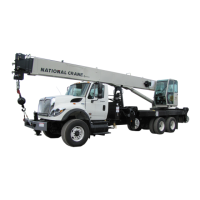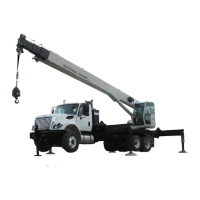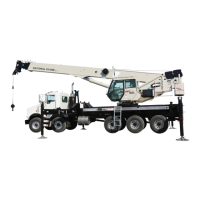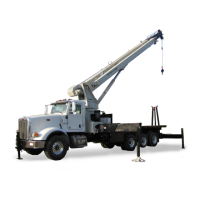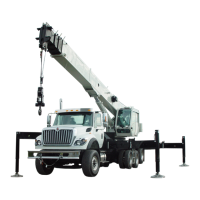Published 3-30-2018, CTRL 636-05 2-25
CD15 OPERATOR MANUAL SAFETY INFORMATION
Grounding the Crane
The crane may become charged with static electricity. This
may occur especially when using outrigger pads made of
plastic or when the outrigger pads are packed with insulating
material (e.g. wooden planks).
Use electrically conducting material for grounding.
1. Hammer a metal rod (3, Figure 2-6) (length of
approximately 2.0 m (6.6 ft)) at least 1.5 m (5 ft) into the
ground.
2. Moisten the soil around the metal rod (3) for better
conductivity.
3. Clamp an insulated cable (2) to the metal rod (3), cross-
section of at least 16 mm² (0.025 inches²).
4. Connect the free end of the cable with a clamp (1) to a
good electrically conductive location on the frame.
PERSONNEL HANDLING
The American Society of Mechanical Engineers publishes
the American National Standard entitled, Personnel Lifting
Systems, ASME B30.23-2016:
This Volume establishes the design criteria, equip-
ment characteristics, and operational procedures
that are required when hoisting equipment within
the scope of the ASME B30 Standard is used to lift
personnel. Hoisting equipment defined by the
ASME B30 Standard is intended for material han-
dling. It is not designed, manufactured, or intended
to meet the standards for personnel handling equip-
ment, such as ANSI/SIA A92 (Aerial Platforms).
The equipment and implementation requirements
listed in this Volume are not the same as that estab-
lished for using equipment specifically designed
and manufactured for lifting personnel. Hoisting
equipment complying with the applicable Volumes
of the ASME B30 Standard shall not be used to lift
or lower personnel unless there are no less hazard-
ous alternatives to providing access to the, area
where work is to be performed. The lifting or lower-
ing of personnel using ASME B30-compliant hoist-
ing equipment is prohibited unless all applicable
requirements of this volume have been met.
This standard is consistent with the U.S. Department of
Labor, Occupational Safety and Health Administration
(OSHA) regulations for Construction that state, in
29CFR1926.1431:
General requirements. The use of a crane or der-
rick to hoist employees on a personnel platform is
prohibited, except when the erection, use, and dis-
mantling of conventional means of reaching the
worksite, such as a personnel hoist, ladder, stair-
way, aerial lift, elevating work platform or scaffold,
would be more hazardous or is not possible
because of structural design or worksite conditions.
Additional requirements for crane operations are stated in
ASME B30.5, Mobile and Locomotive Cranes, ASME B30.8,
Floating Cranes and Floating Derricks, and in OSHA
regulations 29CFR1910.180 for General Industry and
29CFR1926.1431 for Construction.
Use of a Carrydeck crane to handle personnel is acceptable
provided:
• The requirements of the applicable national, state and
local regulations and safety codes are met.
WARNING
Risk of accidents due to electric shock!
Ground the crane before you start to work with it
• Near strong transmitters (radio transmitters, radio
stations, etc.)
• Near high-frequency switching stations
• If a thunder storm is forecast
WARNING
Risk of accidents due to electric shock!
Ensure that the connections between the cable and the
clamp are electrically conductive.
Do not attach the clamp to parts that are screwed on, such
as valves, covers or similar parts.
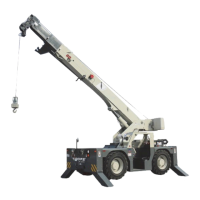
